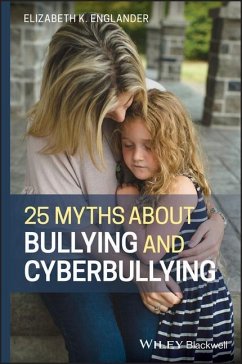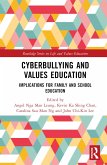Elizabeth K Englander
25 Myths about Bullying and Cyberbullying
Elizabeth K Englander
25 Myths about Bullying and Cyberbullying
- Broschiertes Buch
Andere Kunden interessierten sich auch für
![Combatting Cyberbullying in Digital Media with Artificial Intelligence Combatting Cyberbullying in Digital Media with Artificial Intelligence]() Combatting Cyberbullying in Digital Media with Artificial Intelligence114,99 €
Combatting Cyberbullying in Digital Media with Artificial Intelligence114,99 €![Kids and Today's Media Kids and Today's Media]() Kids and Today's Media118,99 €
Kids and Today's Media118,99 €![Cyberbullying and Values Education Cyberbullying and Values Education]() Cyberbullying and Values Education204,99 €
Cyberbullying and Values Education204,99 €![Papers on Moral Education, Communicated to the First International Moral Education Congress Held at the University of London September 25-29, 1908; Papers on Moral Education, Communicated to the First International Moral Education Congress Held at the University of London September 25-29, 1908;]() Papers on Moral Education, Communicated to the First International Moral Education Congress Held at the University of London September 25-29, 1908;44,99 €
Papers on Moral Education, Communicated to the First International Moral Education Congress Held at the University of London September 25-29, 1908;44,99 €![Metodología para la Planificación Estratégica de un Modelo Ecológico/Holístico para prevenir el acoso escolar (Bullying y Cyberbullying) en las escuelas privadas, públicas e instituciones de educación superior en Puerto Rico (Innovación Disruptiva) Metodología para la Planificación Estratégica de un Modelo Ecológico/Holístico para prevenir el acoso escolar (Bullying y Cyberbullying) en las escuelas privadas, públicas e instituciones de educación superior en Puerto Rico (Innovación Disruptiva)]() Jaime Pizarro FigueroaMetodología para la Planificación Estratégica de un Modelo Ecológico/Holístico para prevenir el acoso escolar (Bullying y Cyberbullying) en las escuelas privadas, públicas e instituciones de educación superior en Puerto Rico (Innovación Disruptiva)40,99 €
Jaime Pizarro FigueroaMetodología para la Planificación Estratégica de un Modelo Ecológico/Holístico para prevenir el acoso escolar (Bullying y Cyberbullying) en las escuelas privadas, públicas e instituciones de educación superior en Puerto Rico (Innovación Disruptiva)40,99 €![23 Myths about the History of American Schools 23 Myths about the History of American Schools]() 23 Myths about the History of American Schools151,99 €
23 Myths about the History of American Schools151,99 €![Seven Myths About Education Seven Myths About Education]() Daisy ChristodoulouSeven Myths About Education272,99 €
Daisy ChristodoulouSeven Myths About Education272,99 €-
-
-
Produktdetails
- Verlag: Wiley
- Seitenzahl: 208
- Erscheinungstermin: 31. März 2020
- Englisch
- Abmessung: 229mm x 155mm x 10mm
- Gewicht: 318g
- ISBN-13: 9781118736500
- ISBN-10: 1118736508
- Artikelnr.: 57749352
Hinweis: Dieser Artikel kann nur an eine deutsche Lieferadresse ausgeliefert werden.
- Herstellerkennzeichnung
- Produktsicherheitsverantwortliche/r
- Europaallee 1
- 36244 Bad Hersfeld
- gpsr@libri.de
DR. ELIZABETH K. ENGLANDER is the Founder and Executive Director of the Massachusetts Aggression Reduction Center at Bridgewater State University. A prolific researcher, she is the Chair of the Cyberbullying Workgroup for the Institute of Child Development and Digital Media, and sits on the Massachusetts Governor's Juvenile Justice Advisory Council. Dr. Englander is a nationally recognized expert in the area of bullying, cyberbullying, and children's use of technology.
About the Author vii
Preface ix
Chapter 1 Why Talk About Myths Instead of Facts? 1
Chapter 2 Bullying is usually about a big kid beating up a smaller kid 11
Chapter 3 Bullying causes suicide and homicide 21
Chapter 4 Bullying is a normal part of childhood 31
Chapter 5 Kids who are small and physically weak are targeted for bullying
41
Chapter 6 The most important thing is what they did to you 51
Chapter 7 Cyberbullying is just like bullying, only on the computer 57
Chapter 8 Bullying and cyberbullying are separate problems 63
Chapter 9 Most adults cannot help kids with computer or Internet issues,
since kids typically know more than they do 69
Chapter 10 Bullying and cyberbullying stop after high school 75
Chapter 11 Cyberbullying is usually anonymous 81
Chapter 12 Cyberbullying is the most emotionally devastating form of
bullying 87
Chapter 13 Bullies have emotional problems 95
Chapter 14 All children all equally vulnerable to bullying 99
Chapter 15 Bullies are raised in dysfunctional families by parents who are
bullies themselves 105
Chapter 16 Revenge is an effective way to handle bullies 111
Chapter 17 Bullies don't understand how much they're hurting the target 117
Chapter 18 Schools don't do anything about bullying 123
Chapter 19 Schools can't take any action in cyberbullying cases 129
Chapter 20 Schools could absolutely stop bullying if they wanted to 135
Chapter 21 When kids shake hands and make up, the bullying stops 141
Chapter 22 There's no point in forcing kids to be nicer to each other,
because they'll just be mean again when the adults aren't there 145
Chapter 23 If only kids would report to adults, the problem would be solved
151
Chapter 24 The best way to stop bullying is for bystanders to confront
bullies and stop bullying episodes 155
Chapter 25 The best way to deal with cyberbullying is to keep kids off
their phones and computers 159
Chapter 26 Just ignore them, and they'll leave you alone. That's the best
strategy for dealing with bullies 163
Conclusion 171
Index 177
Preface ix
Chapter 1 Why Talk About Myths Instead of Facts? 1
Chapter 2 Bullying is usually about a big kid beating up a smaller kid 11
Chapter 3 Bullying causes suicide and homicide 21
Chapter 4 Bullying is a normal part of childhood 31
Chapter 5 Kids who are small and physically weak are targeted for bullying
41
Chapter 6 The most important thing is what they did to you 51
Chapter 7 Cyberbullying is just like bullying, only on the computer 57
Chapter 8 Bullying and cyberbullying are separate problems 63
Chapter 9 Most adults cannot help kids with computer or Internet issues,
since kids typically know more than they do 69
Chapter 10 Bullying and cyberbullying stop after high school 75
Chapter 11 Cyberbullying is usually anonymous 81
Chapter 12 Cyberbullying is the most emotionally devastating form of
bullying 87
Chapter 13 Bullies have emotional problems 95
Chapter 14 All children all equally vulnerable to bullying 99
Chapter 15 Bullies are raised in dysfunctional families by parents who are
bullies themselves 105
Chapter 16 Revenge is an effective way to handle bullies 111
Chapter 17 Bullies don't understand how much they're hurting the target 117
Chapter 18 Schools don't do anything about bullying 123
Chapter 19 Schools can't take any action in cyberbullying cases 129
Chapter 20 Schools could absolutely stop bullying if they wanted to 135
Chapter 21 When kids shake hands and make up, the bullying stops 141
Chapter 22 There's no point in forcing kids to be nicer to each other,
because they'll just be mean again when the adults aren't there 145
Chapter 23 If only kids would report to adults, the problem would be solved
151
Chapter 24 The best way to stop bullying is for bystanders to confront
bullies and stop bullying episodes 155
Chapter 25 The best way to deal with cyberbullying is to keep kids off
their phones and computers 159
Chapter 26 Just ignore them, and they'll leave you alone. That's the best
strategy for dealing with bullies 163
Conclusion 171
Index 177
About the Author vii
Preface ix
Chapter 1 Why Talk About Myths Instead of Facts? 1
Chapter 2 Bullying is usually about a big kid beating up a smaller kid 11
Chapter 3 Bullying causes suicide and homicide 21
Chapter 4 Bullying is a normal part of childhood 31
Chapter 5 Kids who are small and physically weak are targeted for bullying
41
Chapter 6 The most important thing is what they did to you 51
Chapter 7 Cyberbullying is just like bullying, only on the computer 57
Chapter 8 Bullying and cyberbullying are separate problems 63
Chapter 9 Most adults cannot help kids with computer or Internet issues,
since kids typically know more than they do 69
Chapter 10 Bullying and cyberbullying stop after high school 75
Chapter 11 Cyberbullying is usually anonymous 81
Chapter 12 Cyberbullying is the most emotionally devastating form of
bullying 87
Chapter 13 Bullies have emotional problems 95
Chapter 14 All children all equally vulnerable to bullying 99
Chapter 15 Bullies are raised in dysfunctional families by parents who are
bullies themselves 105
Chapter 16 Revenge is an effective way to handle bullies 111
Chapter 17 Bullies don't understand how much they're hurting the target 117
Chapter 18 Schools don't do anything about bullying 123
Chapter 19 Schools can't take any action in cyberbullying cases 129
Chapter 20 Schools could absolutely stop bullying if they wanted to 135
Chapter 21 When kids shake hands and make up, the bullying stops 141
Chapter 22 There's no point in forcing kids to be nicer to each other,
because they'll just be mean again when the adults aren't there 145
Chapter 23 If only kids would report to adults, the problem would be solved
151
Chapter 24 The best way to stop bullying is for bystanders to confront
bullies and stop bullying episodes 155
Chapter 25 The best way to deal with cyberbullying is to keep kids off
their phones and computers 159
Chapter 26 Just ignore them, and they'll leave you alone. That's the best
strategy for dealing with bullies 163
Conclusion 171
Index 177
Preface ix
Chapter 1 Why Talk About Myths Instead of Facts? 1
Chapter 2 Bullying is usually about a big kid beating up a smaller kid 11
Chapter 3 Bullying causes suicide and homicide 21
Chapter 4 Bullying is a normal part of childhood 31
Chapter 5 Kids who are small and physically weak are targeted for bullying
41
Chapter 6 The most important thing is what they did to you 51
Chapter 7 Cyberbullying is just like bullying, only on the computer 57
Chapter 8 Bullying and cyberbullying are separate problems 63
Chapter 9 Most adults cannot help kids with computer or Internet issues,
since kids typically know more than they do 69
Chapter 10 Bullying and cyberbullying stop after high school 75
Chapter 11 Cyberbullying is usually anonymous 81
Chapter 12 Cyberbullying is the most emotionally devastating form of
bullying 87
Chapter 13 Bullies have emotional problems 95
Chapter 14 All children all equally vulnerable to bullying 99
Chapter 15 Bullies are raised in dysfunctional families by parents who are
bullies themselves 105
Chapter 16 Revenge is an effective way to handle bullies 111
Chapter 17 Bullies don't understand how much they're hurting the target 117
Chapter 18 Schools don't do anything about bullying 123
Chapter 19 Schools can't take any action in cyberbullying cases 129
Chapter 20 Schools could absolutely stop bullying if they wanted to 135
Chapter 21 When kids shake hands and make up, the bullying stops 141
Chapter 22 There's no point in forcing kids to be nicer to each other,
because they'll just be mean again when the adults aren't there 145
Chapter 23 If only kids would report to adults, the problem would be solved
151
Chapter 24 The best way to stop bullying is for bystanders to confront
bullies and stop bullying episodes 155
Chapter 25 The best way to deal with cyberbullying is to keep kids off
their phones and computers 159
Chapter 26 Just ignore them, and they'll leave you alone. That's the best
strategy for dealing with bullies 163
Conclusion 171
Index 177








